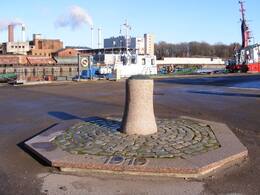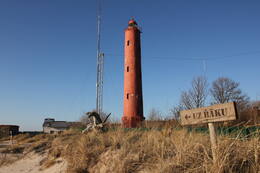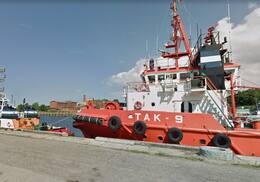Artūrs Ozols' memories of the ship "Saratov"
Artūrs Ozols graduated from Riga Polytechnic and served as a naval officer (midshipman) and engineer in the Russian Black Sea Fleet aboard the warship Panteleimon. During the Latvian Liberation Struggle, he joined the Student Company. In Liepaja he put the ship "Saratov" into service. Arthurs Ozols' memoirs about the ship "Saratov" were published in the Dauagava Vanagi monthly
“The government recognized the need for a floating means of transport so that the government could have a ship to operate with, perhaps to transfer troops to Ventspils. From a strategic point of view, the military had seen it as necessary and also from a moral point of view, so that in the event that everything fell apart and our young army — unarmed, untrained, retreating from Riga to Jelgava, from Jelgava through Kurzeme in the direction of Liepāja — would at least have the awareness that we were taken care of. In the worst case, we would board the ship, and the possibility of retreat would be ensured for us. As my brother Markus, who was at the front, later told me, this awareness gave the fighters at the front new vigor. So they had to look for a ship, but when they looked around, there was no ship. There was only one, a “Saratov” that had tilted on its side. Being a sailor myself, I wanted to orient myself in my specialty and went to the “Saratov” to see what was really there. On the ship I met The stoker was the only person, the engine room was full of water, only one boiler with low pressure. I asked why the water in the engine room was not being pumped out.
"It's none of my business, I don't want to do anything positive for the Germans."
"We Latvians need the ship."
"Ah, that's another matter."
"Saratov" was the only ship that could be at the disposal of the Provisional Government, but it must be obtained from whoever owns it. It turns out that it belongs to the Russian Western Shipping Company, sails under the Russian flag, the captain is Remess, a Latvian who has been there the whole time. How can we get it at our disposal, where German power is all around and we have no say?
I went to Zālītis and said that we could mobilize and seize Saratov. That way the ship came into the hands of the Provisional Government. Why the Germans didn't protest, I don't know. It seems to me that a few weeks later the act would no longer have been successful. The Germans had already organized themselves against the Provisional Government and would not have allowed them to do that. Now the ship had to be put in order and started to repair it. I ran into difficulties: without the person who was already on the ship, I couldn't get anyone to come and help me work. The workers were against the Provisional Government, since they had to fight not only against the Germans, but also against Latvian workers. I didn't get any help for a long time until a neighbor came. The two of us put the ship in order, but there was a lot of work. Then I was called to headquarters.
"Mr. Ozolas, you have to go to sea tomorrow morning."
"But I only have one pot."
"Prepare yourself so that you can go to sea. There is an English squadron there, from which you will take over 5,000 rifles, hundreds of thousands of shells, 50 self-propelled guns. The English do not want to enter here, so as not to cause a conflict with the Germans; the Jurm must go there."
At the end of January, we were moving slowly with one boiler, but we got out very well. We stopped at one of the English warships and in the dark the reloading began. We also got things that had not been seen in Liepāja for a long time. The English were very kind, there was a lot of fraternization. I had to know about the boiler and at the same time go up as an interpreter, because there was no one who knew English and could tell the guys the instructor was teaching how to handle new submachine guns that our guys had not even seen. When everything was settled, we drove back to Liepāja with one boiler and the expensive bullet. The rifles had to be assembled in firing order, people had to be hired, but there was no money. They also had to be delivered to the front, where they were needed. We had to find workers who would not harm our cause. That was the environment in Liepāja at that time.”
Who was Artūrs Ozols?
Artūrs Ozols graduated from Riga Polytechnic School and served as a naval officer (midshipman) and engineer in the Russian Black Sea Fleet on the warship "Panteleimon". He participated in the liberation battles of Latvia as part of the Student Company. He brought the ship "Saratov" into operational order in Liepāja.
He was elected to the Constituent Assembly, then in Edinburgh, Scotland, as an expert, he supervised the construction of our first icebreaker "Krišjānis Valdemārs". For many years he was the director of the Maritime Department. After World War II, he was the first chairman of the board of the National Foundation in Scandinavia in exile. Died in Sweden.
Artūrs Ozols' memories of the ship "Saratov" (Dauagavas Vanagu monthly magazine No. 6, November 1, 1980).
Related timeline
Related topics
Related objects
Berth of the ship "Saratov" in Liepaja
The berth of the "Saratov" is located in Liepaja, at 59 Old Harbour, near the boat docks.
Built in 1888 in Copenhagen by the shipyard Buvmeistar & Wain under the name "Leopold II", in 1911 it was bought by the joint-stock company Russian North-West Shipping and renamed "Saratov", with the Latvian Aleksandrs Remess becoming the ship's captain.
In May 1915, when Liepaja was occupied by German troops, the Saratov was in a damaged state in the harbour.
On 10 January 1919, the steamship Saratov was taken over by the Latvian Provisional Government. From April to July 1919, after the "16 April coup d'état", the Provisional Government headed by K. Ulmanis was on board the Saratov and was forced to take refuge under the protection of the Allied fleet.
On 8 July 1919, after the delivery of the Provisional Government of K. Ulmanis to Riga, the steamers were used for traffic between Riga, Ventspils and Liepaja.
Under the terms of the Peace Treaty of 11 August 1920 between Latvia and Soviet Russia, the steamship Saratov had to be returned to the Soviet side. On 2 January 1923, the steamship was handed over to a Soviet Russian representative. On 15 January 1923, the steamship "Saratov" was wrecked off Akmenrags.
In 1936 the Latvian Maritime Department sold the wreck to a company, which scrapped it and handed it over to the Liepaja Cloth Factory.
Akmeņrags Lighthouse and the fate of the "Saratov"
The Akmeņrags Lighthouse is located in Saka parish, 10 kilometres southwest of Pāvilosta. The top of the lighthouse can be reached by a spiral staircase and it offers views of the sea and the surrounding forests. Standing at 37 metres high, the current lighthouse tower was built in 1921, while the previous lighthouse was destroyed during World War I.
The Akmeņrags Lighthouse stands out among other lighthouses in Latvia, as it is located in one of the most dangerous places for sailing in the entire Baltic Sea coast. The signal beam of the lighthouse marks a rocky bank, which extends approximately two nautical miles or 3.7 kilometres into the sea in a north-western direction. The depth of the bank is just over two metres. The location of the lighthouse has remained unchanged, but the coastline has been receding over the years. Although a navigation light has been here since 1879, Akmeņrags has seen several shipwrecks. The most notable occurred in September 1923 when a Latvian steamer named Saratow struck the ground. In 1919, Saratow briefly served as the seat of the Latvian Provisional Government. Akmeņrags used to be home to a border guard post, and buildings of the Soviet Army are can be viewed here.
The actual berthing location of the ship “Saratov”
The actual berth of the ship “Saratov” is located in Liepāja, at Vecā ostmalā 59 near the boat piers, but the memorial is located in the immediate vicinity of the Liepāja special economic zone.
Built in 1888 in Copenhagen at the shipyard "Buvmeistar & Wain" under the name "Leopold II". In 1911, it was bought by the Russian Northwest Shipping Company and renamed "Saratov", with Latvian Aleksandrs Remess becoming the ship's captain.
In May 1915, when Liepāja was occupied by German troops, the “Saratov” was in the harbor in a damaged condition.
On January 10, 1919, the steamer “Saratov” was taken over for the needs of the Latvian Provisional Government. From April 1919 to July 1919, the Provisional Government led by K. Ulmanis was on board the ship “Saratov” after the “April 16 Coup”, which was forced to seek refuge under the protection of the Allied fleet.
On July 8, 1919, after the Provisional Government of K. Ulmanis was brought to Riga, the steamer was used in traffic between Riga, Ventspils and Liepāja.
According to the terms of the peace treaty between Latvia and Soviet Russia of August 11, 1920, the steamer “Saratov” had to be returned to the Soviet side. On January 2, 1923, the steamer was handed over to the representative of Soviet Russia. On January 15, 1923, the steamer “Saratov” was lost near Akmeņrags.
In 1936, the Latvian Maritime Department sold the shipwreck to a company that raised it and handed it over for scrap metal to the Liepāja Wire Factory.








